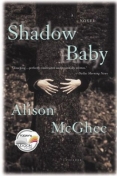BKMT READING GUIDES
Shadow Baby
by Alison McGhee
Published: 2003
Paperback : 243 pages
Paperback : 243 pages
2 members reading this now
1 club reading this now
0 members have read this book
1 club reading this now
0 members have read this book
Eleven-year-old Clara is struggling to find the truth about her missing father and grandfather and her dead twin sister. When she begins interviewing her elderly neighbor, Mr. Kominsky, she invents versions of his past and makes up lives for the people missing from her own shadowy ...
No other editions available.
Jump to
Introduction
Eleven-year-old Clara is struggling to find the truth about her missing father and grandfather and her dead twin sister. When she begins interviewing her elderly neighbor, Mr. Kominsky, she invents versions of his past and makes up lives for the people missing from her own shadowy history.
Discussion Questions
Discussion Questions from Publisher's Reading Guide:1. One of the underlying themes in Shadow Baby is art, what it is, the people who make it, the people who appreciate it. (Think about, for example, Clara's soliloquy on book reports vs. actual books.) Clara believes that the old man has taught her the "art of possibility, and the possibility of beauty." What do you think the book is saying about the process of creating art? What are your own feelings on that subject?
2. In many ways the novel is a study in opposites. For example, Clara lives for words, while the old man is illiterate. In what ways do such contrasts serve to illuminate and deepen Clara's understanding of life?
3. In what ways do Clara's fake book reports mirror her world? In what ways do they represent her inner psyche? Why does she burn them all up in the end?
4. Shadow Baby opens with this line, "Now that the old man is gone, I think about him much of the time." Clara is twelve years old as she narrates the book, looking back on the past year of her life. Because she is still very young, she is not capable of having a long perspective of time, yet the book ends with this line, "But I was a child then." Think about other fictional child narrators, e.g., Holden Caulfield in A Catcher in the Rye and Laura Ingalls Wilder in the Little House books, and discuss the events behind their transition into adulthood. Compare and contrast to Clara's.
5. Clara's mother Tamar practices weekly in a church choir. Yet Tamar never attends church, nor do the old man or Clara. Is there nonetheless some religious significance in the book?
6. What is the significance of the title?
7. While it is true that the mother-daughter relationship in the novel is difficult, did you find it believable and real? Why does Tamar refuse to answer Clara's questions?
8. To Clara, "real life" is often indistinguishable from her fantasy life. What purpose does her wild imagination serve?
9. The story of Clara's relationship with CJ Wilson is intertwined with the story of her chickens. How do the two stories both reflect and enlarge each other?
10. In the book, one person looks at a dented tin can and sees garbage, another looks at the same can and sees the possibility of beauty in the form of a lantern or cookie cutters. How does the book play with ideas of how individual ways of seeing influence one's experience of the world?
11. Clara is obsessed with pioneers, their stories of incredible hardship and triumph over adversity. Can the book in some ways be viewed as a metaphor (or possibly an anti-metaphor) for the traditional American mythology surrounding its immigrant past?
12. Think about the opening scene of the book, in which Clara glimpses the old man hanging lanterns in the woods. Think about the ending scene, in which she is burning her fake book reports in the snow. How do these two scenes, which 'bookend' the novel, mirror each other? What do they tell us about how Clara has changed in the interim?
10. In the book, one person looks at a dented tin can and sees garbage, another looks at the same can and sees the possibility of beauty in the form of a lantern or cookie cutters. How does the book play with ideas of how individual ways of seeing influence one's experience of the world?
11. Clara is obsessed with pioneers, their stories of incredible hardship and triumph over adversity. Can the book in some ways be viewed as a metaphor (or possibly an anti-metaphor) for the traditional American mythology surrounding its immigrant past?
12. Think about the opening scene of the book, in which Clara glimpses the old man hanging lanterns in the woods. Think about the ending scene, in which she is burning her fake book reports in the snow. How do these two scenes, which 'bookend' the novel, mirror each other? What do they tell us about how Clara has changed in the interim?
Weblinks
| » |
Publisher's Book Info
|
| » |
Publisher's Reading Guide
|
| » |
Author Interview from Publisher
|
| » |
Today Show August 2003 Book Club Selection
|
Book Club Recommendations
Recommended to book clubs by 0 of 0 members.
MEMBER LOGIN
BECOME A MEMBER it's free
Book Club HQ to over 90,000+ book clubs and ready to welcome yours.
SEARCH OUR READING GUIDES
Search
FEATURED EVENTS
PAST AUTHOR CHATS
JOIN OUR MAILING LIST
Get free weekly updates on top club picks, book giveaways, author events and more
Get free weekly updates on top club picks, book giveaways, author events and more
Please wait...








